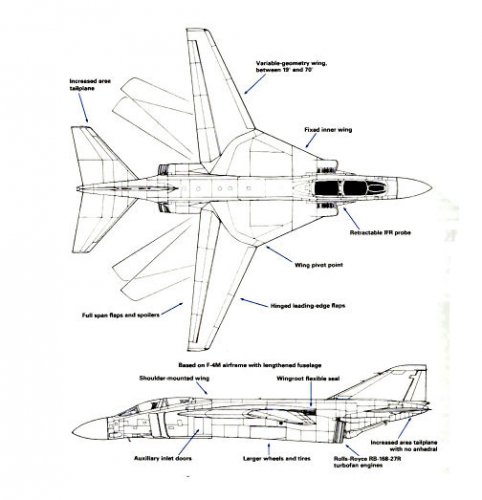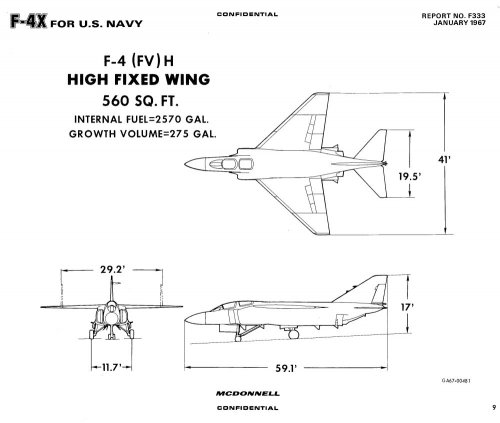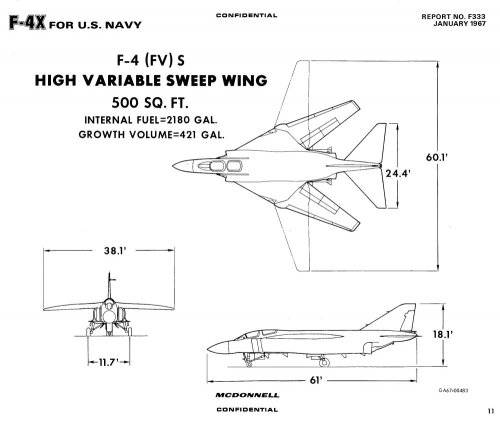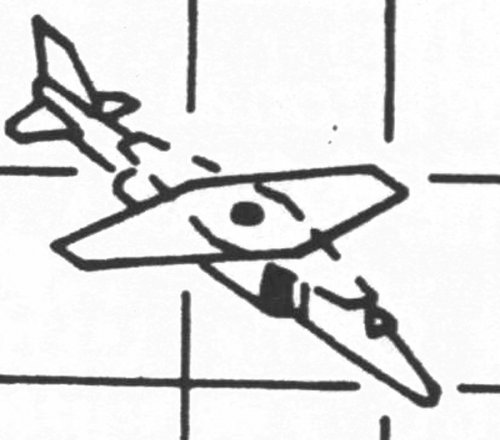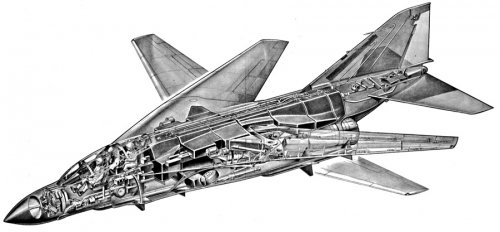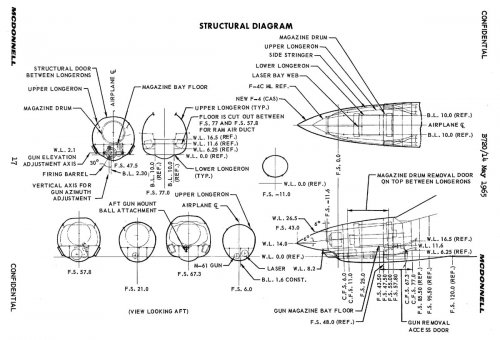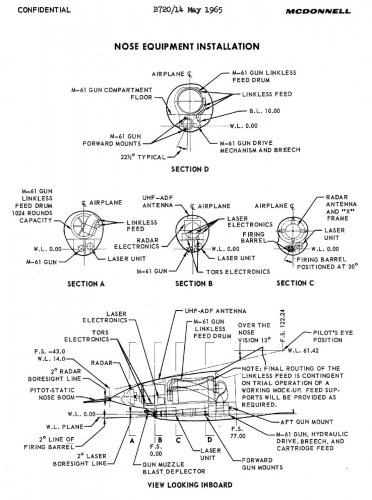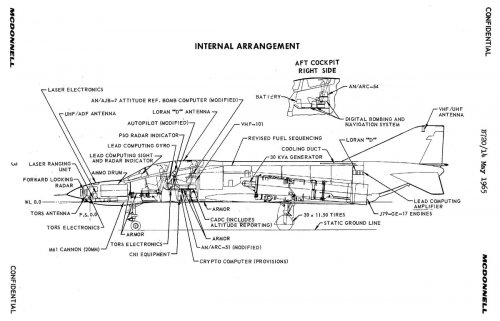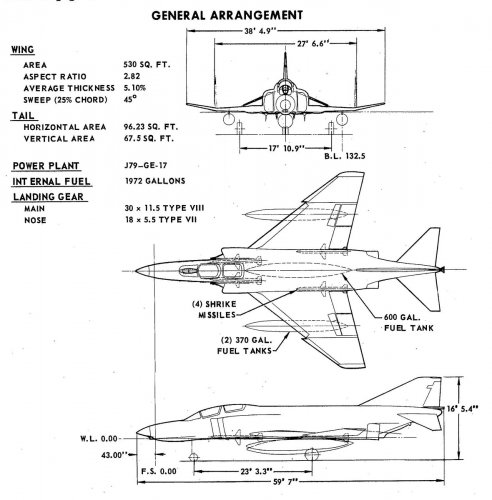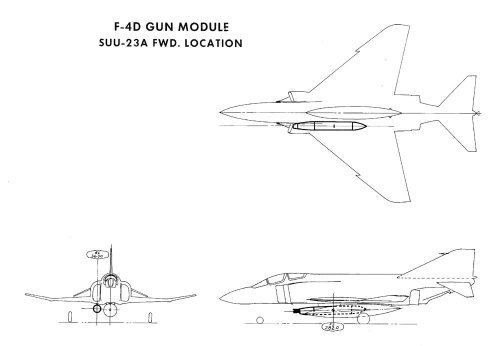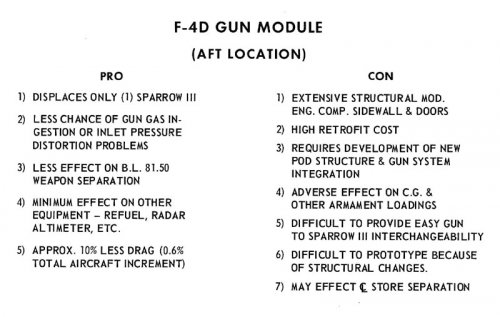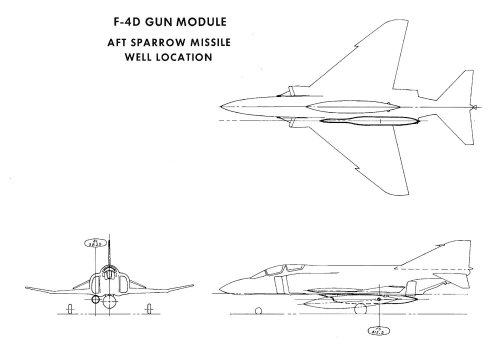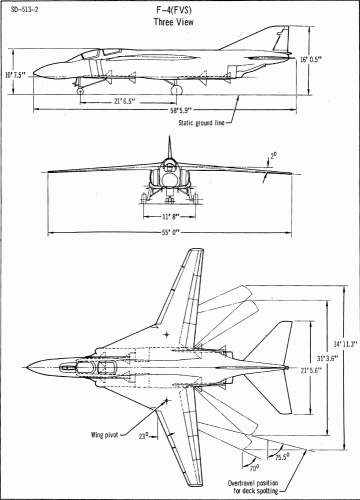You are using an out of date browser. It may not display this or other websites correctly.
You should upgrade or use an alternative browser.
You should upgrade or use an alternative browser.
Advanced Phantom Projects
- Thread starter rousseau
- Start date
canisd
ACCESS: Restricted
- Joined
- 29 September 2006
- Messages
- 1,700
- Reaction score
- 1,182
rousseau said:Greetings:
Who would like to tell me how many swing-wing vertions of F-4 PhantomII has existed? Would you please take trouble to show me those drawing?
Thanks in advance
Joe Baugher's pages indicate that there were two VG versions of the Phantom considered - the F-4J(FV)S derived from the F-4J, for the USN; and the F-4M(FV)S derived from the F-4M, for the RAF. http://home.att.net/~jbaugher1/f4_33.html
Looking at the bigger engine section in your picture, it looks like that is the F-4M(FV)S for the RAF.
Hope that helps.
Starviking
- Joined
- 29 September 2006
- Messages
- 1,700
- Reaction score
- 1,182
- Joined
- 29 September 2006
- Messages
- 1,700
- Reaction score
- 1,182
Archibald said:This plan also could be find on the Key Publishing board
Thanks for that Archibald, I can hardly ever remember where I get my pics from. :'(
Starviking
- Joined
- 27 December 2005
- Messages
- 16,924
- Reaction score
- 21,797
Phantom FV Challenging F-111B
THE MCDONNELL PHANTOM development studied as an alternative to the GD/ Grumman F-111B for the US Navy is understood to be designated the Phantom FV. A Navy-funded project study has been under way at St Louis for some months, reflecting official doubts about the prospects of the F-111B intercepter ever reaching fleet service in the face of severe difficulties with its Phoenix missile system, and on the score of excessive weight. The Phantom FV has increased wing area and is projected around the -10 development of the J79 engine. This powers the new F-4J Phantom now proceeding along the early stages of the St Louis assembly line in parallel with the first YF-4Ks for Britain. The -10 has about 9001b more static sea-level thrust that J79s in current production Phantoms. Another major innovation projected for the FV is a discriminatory multi-shot fire-control system (see Sensor, December 16) with a capacity to lock on to as many as six targets simultaneously. The most threatening target at any one time is selected automatically for attack and the process continues in a descending order of threat.
STRETCHED PHANTOM ENTERS LISTS
A STRETCHED MCDONNELL PHANTOM, with potentially an even greater proportion of British equipment and components than the present F-4Ks and Ms ordered by Britain, has been submitted by McDonnell as an eleventh-hour contender in the TSR.2 replacement battle. Following the virtual elimination of the Buccaneer S.2* from serious consideration for the RAFs primary strike/recce role, the choice now lies between the all-American F-111 and the partly-anglicised Spey-Mirage and Spey-Phantom FV, with the Air Staff doggedly sticking to its preference for the first-named type. Both MoD (Air) and MoA press officers hastened last week to deny that the stretched Phantom was being seriously considered. The Air Department, in its pressing for the F-111, could hardly say otherwise, but evidence suggests that the proposal is far from dead elsewhere. The Phantom FV (first mentioned in Flight for December 30) began life as a $1 million (£357,000) USN-funded feasibility / preliminary design study which is due for completion in August this year and for which extra funds are expected imminently. Intended essentially as an alternative to the problematical,over-weight F-111B, the Phantom FV would be about 20,000lb lighter. It would have an improved -10 version of the J79 engine and a larger wing area than present Phantoms, and be equipped for the air-superiority fighter role with Sparrow missiles, in place of the F-111B's Phoenix. It would have significant increases in ferry range (and CAP endurance), speed and payload over existing F-4 versions. The Phantom FV could be rolled out in the summer of 1968 if the present study is followed by a development contract. The essential changes to present USN Phantom versions, through which the Phantom FV is evolved, are equally applicable to the anglicised F-4Ks and Ms, for the RN and RAF respectively. The fuselage is little changed in the stretched version; having already been substantially redesigned in the case of the K and M to accommodate the Spey 25R, the K/M fuselage structure would carry over into a British version of the FV. The powerplant would be the RB.168-27R, a projected development of the current engine in which changes are made mainly to the afterburner and nozzle with, possibly, an extra compressor stage being added for increased mass flow. The thrust is little changed over the -25R but the s.f.c. is significantly improved.
The Spey-powered Phantom FV could carry the advanced air-to-ground radar, head-up display, terrain-following and map-matching systems developed for the Buccaneer S.2*, together with the inertial-navigation system, the navigation computer and the weapons-release computer which are going into the F-4M. (There would be ample space, too, for reconnaissance systems to be carried internally). Such heavy British participation on the electronics side, together with the logical extension to the FV of British sub-contract arrangements already made for the F-4K and M (e.g., outer wings by Shorts, rear fuselage and tail surfaces by BAC) would raise the value of British manufacture to about 60 per cent of the total aircraft cost. The present value of British participation in the F-4K and M is about 52 per cent of total cost.
McDonnell is pushing strongly the high level of British participation if the Spey-Phantom FV were chosen in preference to the F-lll, with the political attractions of extending work for the British industry, the logistic advantages of local component production and wide spares interchange with the K and M, and the economic attractions of its overall cost This is claimed to be less than 50 per cent of any recent, realistic estimate of the F-lll's cost, which is now approaching £3 million. There would be little conversion training for pilots experienced on the earlier Phantoms lready ordered, and the Spey-Phantom FV could be ready in 1969. It is claimed that the aircraft would meet 90 per cent of the requirements of OR.343, the TSR.2 specification—a claim which, if valid, represents scarcely any greater shortfall of the TSR.2 OR than that required to "fit" the F-111, and probably less than the shortfall which would result from adoption of the Spey-Mirage.
- Joined
- 13 June 2007
- Messages
- 2,101
- Reaction score
- 2,706
- Joined
- 27 December 2005
- Messages
- 16,924
- Reaction score
- 21,797
I like the fixed wing design.
- Joined
- 14 June 2006
- Messages
- 2,297
- Reaction score
- 487
This is an absolute first, AFAIK. During the studies for the VG Phantom, MDD considered a single pivot (AKA oblique or skewed wing) configuration with an aspect ration of 6 wing. The solution was finally rejected on account that to have the same low-speed performance the airframe had to be stretched by 12 feet to accomodate the long span wing in closed position, reaching so 70 feet in overall lenght, too much for a carrier aircraft, MDD thought. The tail section too was reworked as it is apparent from the ortho view. Images for a SAE MDD paper form 1965 on "Aerodynamic design considerations of variable geometry aircraft".
Attachments
- Joined
- 13 June 2007
- Messages
- 2,101
- Reaction score
- 2,706
Wow Skybolt - quite the find! Thanks for posting!
Enjoy the Day! Mark
Enjoy the Day! Mark
- Joined
- 17 October 2006
- Messages
- 2,354
- Reaction score
- 988
The skewed wing, if you could make it work at the top speed range, was all kinds of awesome for carrier suitability. High sweep for supersonic (although I have never heard anyone suggest that it was a good idea at much above M=1.8), huge span, zero sweep for landing and a tiny spot factor.
shockonlip
ACCESS: Top Secret
- Joined
- 29 January 2008
- Messages
- 605
- Reaction score
- 50
Hard to eject at high speed, unless you make other plans.
But there is a certain elegance here (and high speed potential).
Note how the maximim cord of the wing in slow speed mode can
become the high speed span.
But there is a certain elegance here (and high speed potential).
Note how the maximim cord of the wing in slow speed mode can
become the high speed span.
- Joined
- 27 December 2005
- Messages
- 16,924
- Reaction score
- 21,797
- Joined
- 1 May 2007
- Messages
- 2,537
- Reaction score
- 1,752
Hard to eject at high speed, unless you make other plans...
Note how the maximim cord of the wing in slow speed mode can
become the high speed span.
I wouldn't have thought that the wing would pivot through the full 90 degrees for high-speed flight, probably no more than 60, [just my opinion]
Cheers,
Robin.
M
McColm
Guest
Hi Guys,
Fantastic Plastic had a prototype model of the F-4(FV)S. I'm not sure if it ever went into production, I just saw pictures of the different stages.
Fantastic Plastic had a prototype model of the F-4(FV)S. I'm not sure if it ever went into production, I just saw pictures of the different stages.
overscan said:Swing wing Phantom
Great find - what's the source if I may ask?
Regards,
Greg
- Joined
- 27 December 2005
- Messages
- 16,924
- Reaction score
- 21,797
Mark Nankivil. Apologies for failing to say that before 
overscan said:Mark Nankivil. Apologies for failing to say that before
Thanks, Mark - same question?
Regards,
Greg
- Joined
- 13 June 2007
- Messages
- 2,101
- Reaction score
- 2,706
From the Greater St. Louis Aviation Museum archives. It was in with some items donated by a retired McDonnell/McAir engineer. I would say Grade 6 
Enjoy the Day! Mark
Enjoy the Day! Mark
- Joined
- 13 June 2007
- Messages
- 2,101
- Reaction score
- 2,706
Greetings All -
I've scanned another report in the same batch at the museum "F-4 Modernization Program - Phantom II+ For The 21st Century" dated January, 4, 1985. This was a proposal to the USAF for a thorough overhaul to the Phantom including new avionics, glass cockpit, new engines (PW1120, F404 and an improved J-79) and various other tricks and upgrades to get the most out of the basic airframe. Fuel fraction was a rather important part of the overall proposal and the following drawings were in the report showing what was looked at and what was proposed.
Enjoy the Day! Mark
I've scanned another report in the same batch at the museum "F-4 Modernization Program - Phantom II+ For The 21st Century" dated January, 4, 1985. This was a proposal to the USAF for a thorough overhaul to the Phantom including new avionics, glass cockpit, new engines (PW1120, F404 and an improved J-79) and various other tricks and upgrades to get the most out of the basic airframe. Fuel fraction was a rather important part of the overall proposal and the following drawings were in the report showing what was looked at and what was proposed.
Enjoy the Day! Mark
Attachments
-
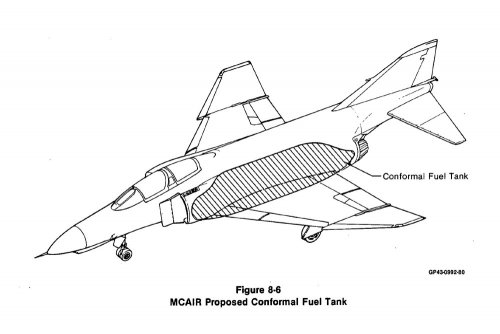 Phantom II+ Proposed Conformal Fuel Tank.jpg85.4 KB · Views: 1,237
Phantom II+ Proposed Conformal Fuel Tank.jpg85.4 KB · Views: 1,237 -
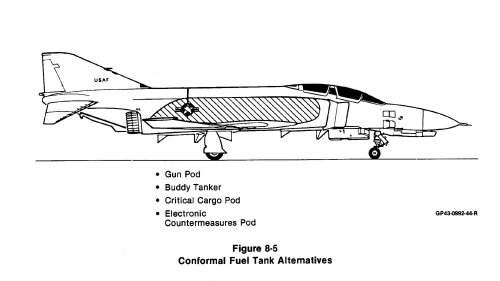 Phantom II+ Conformal Fuel Tanks Alternatives.jpg70.2 KB · Views: 1,213
Phantom II+ Conformal Fuel Tanks Alternatives.jpg70.2 KB · Views: 1,213 -
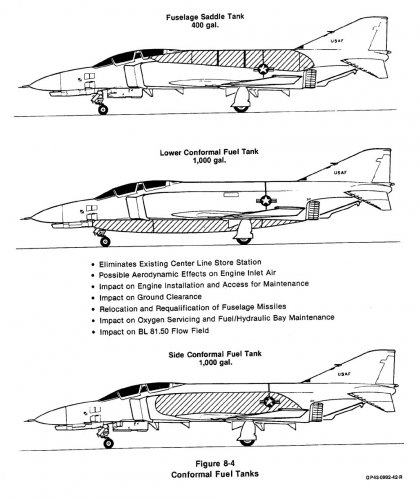 Phantom II+ Conformal Fuel Tanks.jpg192.3 KB · Views: 1,782
Phantom II+ Conformal Fuel Tanks.jpg192.3 KB · Views: 1,782 -
 Phantom II+ External Fuel Non-Droppable.jpg67.9 KB · Views: 1,717
Phantom II+ External Fuel Non-Droppable.jpg67.9 KB · Views: 1,717 -
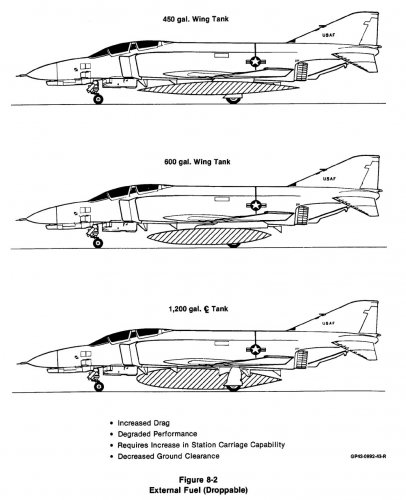 Phantom II+ External Fuel Droppable.jpg169.6 KB · Views: 1,866
Phantom II+ External Fuel Droppable.jpg169.6 KB · Views: 1,866 -
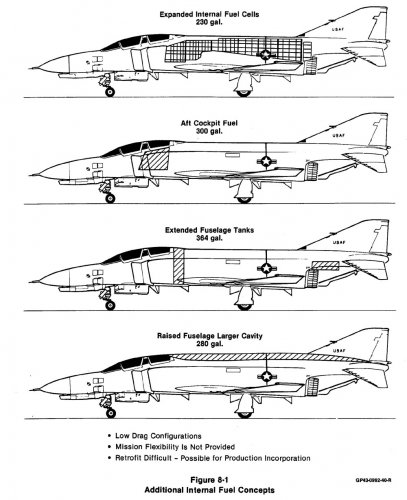 Phantom II+ Internal Fuel Options.jpg202.7 KB · Views: 1,977
Phantom II+ Internal Fuel Options.jpg202.7 KB · Views: 1,977
M
McColm
Guest
Great pictures, just need to find a F-4 Phantom kit donor and have a go.
- Joined
- 13 June 2007
- Messages
- 2,101
- Reaction score
- 2,706
Greetings All -
Though predating the time frame that the thread started off with, it seems this thread best fits the bill for sharing this info. I found this in some additional McAir reports looking at variants or upgrades to the F-4C and F-4D that are in the Greater St. Louis Air & Space Museum archives.
First off is this proposed CAS variant of the F-4C. You can see some elements of the later F-4E gun installation in this layout.
Enjoy the Day! Mark
Though predating the time frame that the thread started off with, it seems this thread best fits the bill for sharing this info. I found this in some additional McAir reports looking at variants or upgrades to the F-4C and F-4D that are in the Greater St. Louis Air & Space Museum archives.
First off is this proposed CAS variant of the F-4C. You can see some elements of the later F-4E gun installation in this layout.
Enjoy the Day! Mark
Attachments
- Joined
- 13 June 2007
- Messages
- 2,101
- Reaction score
- 2,706
...and an F-4D gun module proposal. Would seem the lack of a gun was trying to be addressed with an add on but would later be addressed properly with the F-4E. I've seen SUU-23 pods mounted on the centerline and inboard wing pylons but never in the Sparrow wells as proposed here.
Enjoy the Day! Mark
Enjoy the Day! Mark
Attachments
XP67_Moonbat
ACCESS: Top Secret
- Joined
- 16 January 2008
- Messages
- 2,259
- Reaction score
- 461
Like an upgraded "Chico The Gunfighter"?
http://www.hyperscale.com/features/2000/f4ewm_1.htm
http://www.hyperscale.com/features/2000/f4ewm_1.htm
- Joined
- 13 June 2007
- Messages
- 2,101
- Reaction score
- 2,706
Here's one more that fits here better than any other thread. From a September 1, 1970 summary report, here are a couple of pages of the proposed single seat version of the F-4E(F) for West Germany. I always had in mind a single canopy version for the initially proposed single seater but as shown, the canopy stayed the same but the aft cockpit is fully stripped out so as to save weight. The listing of weight reductions is interesting too.
Enjoy the Day! Mark
Enjoy the Day! Mark
Attachments
- Joined
- 13 June 2007
- Messages
- 2,101
- Reaction score
- 2,706
Here's a few more items related to the McAir proposal to the Navy for the F-4 (FVS). The drawing is from the detail specification and the PDF is a compilation of the airframe specs out of that detail spec.
There's enough info there to help someone come out with a model (hint, hint!).
Enjoy the Day! Mark
There's enough info there to help someone come out with a model (hint, hint!).
Enjoy the Day! Mark
Attachments
Last edited:
- Joined
- 8 January 2006
- Messages
- 1,605
- Reaction score
- 730
Mark Nankivil said:Here's one more that fits here better than any other thread. From a September 1, 1970 summary report, here are a couple of pages of the proposed single seat version of the F-4E(F) for West Germany. I always had in mind a single canopy version for the initially proposed single seater but as shown, the canopy stayed the same but the aft cockpit is fully stripped out so as to save weight. The listing of weight reductions is interesting too.
I was thinking the emptied aft cockpit could become another avionics bay for the single-seater. I could also see returning to the original canopy lines of the F4H-1 since improved headroom for the backseater would no longer be a concern. It'd be fun to couple this with some of the other upgrades discussed here as well as the extreme proposed F-4EJ-Kai mentioned in the Aerofax minigraph on the F-4E, it was rewinged with a new wing derived aerodynmaically from the F-15's wing. It could make for a very different-looking Phantom II.
- Joined
- 27 December 2005
- Messages
- 16,924
- Reaction score
- 21,797
Merged some existing topics.
Mark Nankivil said:I've scanned another report in the same batch at the museum "F-4 Modernization Program - Phantom II+ For The 21st Century" dated January, 4, 1985. This was a proposal to the USAF for a thorough overhaul to the Phantom including new avionics, glass cockpit, new engines (PW1120, F404 and an improved J-79) and various other tricks and upgrades to get the most out of the basic airframe.
I'm very much interested in the Phantom II+ proposal, particularly the F404-powered one.
Is there further description and/or even some illustration of the re-engining idea?
Thanks in advance.
- Joined
- 13 June 2007
- Messages
- 2,101
- Reaction score
- 2,706
Mark Nankivil said:Attached is the section noting the engine options/selection. The F-404 is mentioned but rather quickly dismissed.
HTH! Mark
Yes it does help a lot! Thanks!
- Joined
- 13 June 2007
- Messages
- 2,101
- Reaction score
- 2,706
My pleasure! Mark
- Joined
- 8 January 2006
- Messages
- 1,605
- Reaction score
- 730
Fascinating reading for someone "in the business". It's a good example of tradeoffs and, if memory serves me correctly, that "Combat Plus" system was originally developed for the F-16/79. I suspect that there may have been other reasons for the quick dismissal of the F404-powered version, I can see the community for the F-18 wanting to make sure that nothing disturbed Cognress' support for the F-18.
- Joined
- 27 March 2006
- Messages
- 1,842
- Reaction score
- 1,520
I notice that they were talking about an increase in thrust in the new J-79 version, but omit to mention what exactly the total thrust improvement was. Anybody know?
- Joined
- 8 January 2006
- Messages
- 1,605
- Reaction score
- 730
kaiserbill said:I notice that they were talking about an increase in thrust in the new J-79 version, but omit to mention what exactly the total thrust improvement was. Anybody know?
Check available info on the F-16/79 for which that system was developed. I'd be going by memory at this point and it's been way too long for me to trust that on this info.
Similar threads
-
-
'Demon' to 'Phantom' - the evolution of McDonnell's F-4 Phantom II
- Started by Archibald
- Replies: 38
-
McDonnell Douglas little known airliners
- Started by hesham
- Replies: 160
-
McDonnell Models 146 SIDEKICK and 189 anti-tank missiles
- Started by Stargazer
- Replies: 4
-


